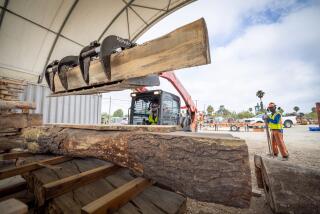Building Block
Southern California housing permits were up nearly 20% in the first quarter, and most other signs have been making 1996 look like it will be the healthiest season for the housing industry in years.
But soaring lumber prices now threaten to slash builders’ profits and force price hikes that could drive buyers out of a market that has been in a recession since 1990.
Developers said they may have to bump up their prices to account for a 30% jump in the cost of some lumber products since the beginning of the year. And in a classic damned-if-you-do, damned-if-you-don’t scenario, they said, the same pent-up demand for homes that is finally giving them sales is likely to cause lumber prices to go up further in coming months.
Builder Randall Lewis said that for many in the industry, the alternative to holding the line on prices is to stop building, but home builders won’t do that while there is any demand in the market.
He acknowledged that higher prices will probably cut into sales but said “that’s better than not building at all” for Lewis Homes, a giant Upland builder with projects in Los Angeles, Orange, Riverside and San Bernardino counties.
A Commerce Department report Thursday that home starts unexpectedly rose almost 6% nationwide in April to a two-year high dashed hopes for an immediate drop in lumber prices. Economists had predicted a decline in construction starts during the month.
“The high prices are firming up,” said Will Higman, vice president of Reliable Wholesale Lumber Inc.
“Money is tight for most builders, and their profit margins are really small these days,” said the lumberman, whose Huntington Beach company distributes lumber to home builders throughout Southern California.
“Price hikes like we’ve seen in the last few weeks just puts ‘em into shock,” Higman said.
If lumber costs do boost housing prices, that could push thousands of potential buyers out of the market and put the brakes on a recovery that seems to have just begun.
“It would be especially hard for some of the first-time buyers to qualify,” said Christine Larson, vice president of consumer lending at Sanwa Bank in Hawthorne.
“Most lenders have programs to get first-time buyers in with minimal down payments, and people are stretched to the limit even to do that. An extra $2,500, or even an extra $1,000, is pretty hard for most to come up with.”
*
Even for move-up buyers, the extra cost could make a difference, boosting down payments or turning standard loans into jumbo mortgages with higher interest rates and higher monthly payments, Larson said.
Rick Hormuth, president of Orange County Lumber Co. in Rialto, said that the builders he supplies are planning to pass on the higher costs. “A rise in interest rates is a bigger problem and worries them more than increasing the cost of the house by a few thousand dollars,” he said. “A home buyer who’s worried can always drop a carpet or tile upgrade to make up the difference, but you can’t do that if interest rates go up.”
Lumber prices also soared in late 1993 and early 1994, but the building market was mired in a deep recession. Home sales were moribund, and builders with projects underway had little alternative but to absorb the increased costs or change their building plans to cut down on the amount of lumber they used.
One result was the demise of tract homes with complex architectural features. The industry resumed “big box” building that eliminated nooks, gabled roofs and multilevel window layouts that required more lumber.
Most of those cost-cutting practices are still being employed, leaving few alternatives now to raising home prices.
Builders said they’ve already cut their margins to the bone after six years of recession in Southern California’s housing industry and cannot afford to absorb the higher lumber prices.
Thanks largely to the soaring increases in the price of framing lumber, like 2-by-4s, the cost to builders of a houseful of wood products is up about 10% since the beginning of the year. For a mid-size Southern California tract home that sells for $250,000, that’s an increase of nearly $2,500, a cost hike that eats up a hefty chunk of many builders’ profits.
One Southern California builder said that his gross profit is now half the 10% per home the industry considered normal in pre-recession times. A $2,500 reduction in earnings on a $250,000 home, he said, would cut away 20% of the company’s remaining profit.
Another builder, Newport Beach-based Warmington Homes, already has increased prices or eliminated incentives such as free landscaping in some of its 19 projects because of increased buyer demand, said Larry Riggs, executive vice president.
The lumber situation “is just putting that much more pressure on all of us to begin inching up our prices,” he said. “There’s just no more room to absorb [higher] costs.”
Until now, lumber prices have been rising because of shortages in supply, caused in part by cash-strapped builders’ own just-in-time ordering systems that have eliminated stockpiles of lumber.
But builders and lumber industry insiders said that demand from the flood of first-quarter construction permits is likely to keep lumber prices high at least through the summer, even when mills are producing at full capacity.
The supply shortage causing the current price spiral was compounded by a seemingly unrelated drop in demand for paper products over the winter.
It’s a graphic illustration of how tightly interlinked seemingly disparate parts of the economy really are.
Lumber mills sell the wood chips left over from lumber production to paper mills, which turn the chips into wood pulp, the main ingredient of most paper.
When demand for paper is high, as it was in 1994 and 1995, mills cut a lot of dimensional lumber during the winter months, stockpiling it for builders’ spring orders and churning out an ample supply of wood chips in the process.
This winter, however, the market for pulp dried up and the mills had no incentive to cut lumber to produce chips. So as builders’ spring orders started coming in at a bigger-than-expected volume, there was little framing lumber in the pipeline and prices quickly started climbing, said Burrle Elmore, editor of Random Lengths, the Oregon-based lumber industry newsletter.
Still, not all builders are ready to pass the extra costs along to their buyers.
“There are two separate issues here: costs and demand,” said Larry Webb, president of John Laing Homes in Irvine. “Demand in the market tells us what it can support by way of price increases, and I don’t feel this is a cost that can be passed on. I think we’re already getting what buyers are willing to pay for our homes.”
(BEGIN TEXT OF INFOBOX / INFOGRAPHIC)
Stiff Prices
Lumber price increases this year have added about $2,500 to builder costs for a mid-range Southern California tract house.
Housing Costs
Combined cost of wood products for a 2,800-square-foot home, in thousands:
May: $27.4
Framing Lumber
Weekly wholesale price per thousand board feet:
May: $419
Note: Includes framing lumber, floor-joist system, roof trusses, plywood floor and roof sheeting.
Sources: Reliable Wholesale Lumber; Random Lengths Publications, Eugene, Ore.
Researched by JOHN O’DELL and JANICE L. JONES / Los Angeles Times
By the Board
Stocks of major wood-products companies such as Weyerhaeuser Co. and Boise Cascade Corp. have surged this year as wood price have jumped. Weekly closes on the NYSE and latest:
Weyerhaeuser
Thursday: $48.25
Boise Cascade: $45.38
Thursday: $45.38
Source: TradeLine
More to Read
Inside the business of entertainment
The Wide Shot brings you news, analysis and insights on everything from streaming wars to production — and what it all means for the future.
You may occasionally receive promotional content from the Los Angeles Times.










